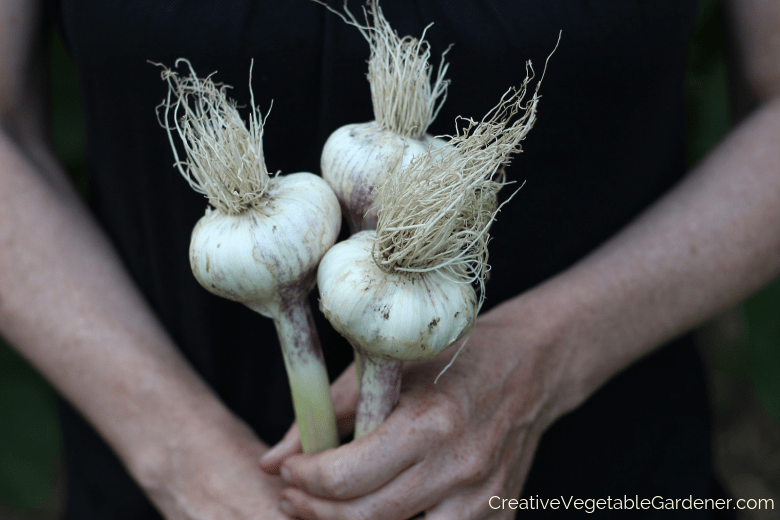
Planting garlic in fall is a symbolic act in my opinion. You’re declaring to Mother Nature that you’re coming back next year and are already planning for the harvest.
The cyclical nature of the gardening season is beautifully represented in your garlic crop’s progression throughout the year – planting in fall, hibernating in winter, sprouting in spring, and the harvest in summer.
In my northern garden in Wisconsin there aren’t too many things that can survive the harsh winters here, so garlic is a super vegetable in my book!
Planting garlic is one task that should definitely be on every cold climate gardener’s to-do list in fall. I’ve already covered the reasons why you should grow your own garlic, so I’m going to assume my persuasive powers have succeeded and you’re ready to start planting.
In this post and accompanying video, I’ll show you step-by-step how and when to go about planting garlic in fall so you have a bumper crop the next season.

Anatomy of a Garlic Plant
Before you rush out and start planting, let’s make sure you’re familiar with the different parts of the garlic plant.
Garlic is part of the allium family, which includes onions, leeks, shallots, scallions, and chives.
The scape is the central stalk that goes up and then usually makes a loop. It emerges in late spring. It’s like a bonus crop because you can use it in cooking and even to make a yummy garlic scape pesto.
At the end of the scape is the spathe. This is the outer covering around the flower and eventually the bulbils.
The bulb is the collection of cloves.
And the individual cloves are what you plant in your garden in fall.
It’s pretty easy to tell the difference between an onion and a garlic plant – garlic has flat leaves like a leek and onions have round leaves.
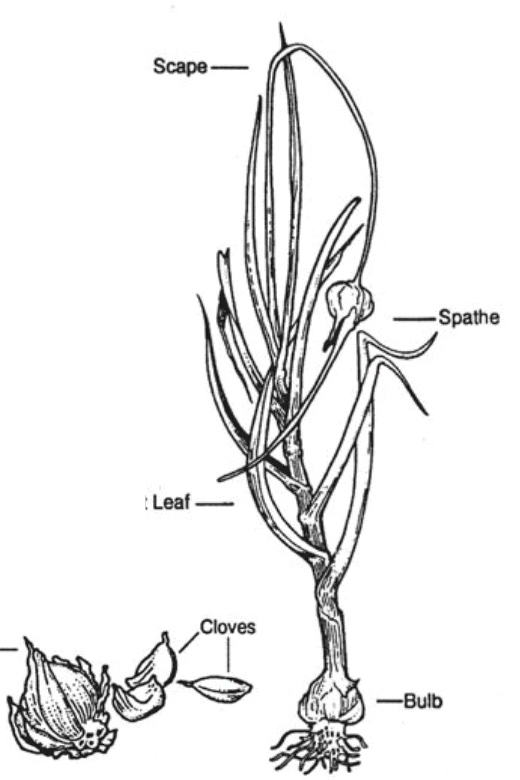
What Kind of Garlic to Plant
I have a separate article that helps you choose which varieties of garlic to plant in your garden. It explains the different types of garlic, walks you through some questions to ask yourself to help you determine what variety might be best for you. I share my recommended garlic varieties and where to grow them.
What Month Do You Plant Garlic in Fall?
In northern climates in the US, garlic is generally planted between mid-October through the end of November. I wait until after my first frost so I can clean out the garden beds where the warm weather crops like tomatoes and eggplant were growing so I can make room for garlic planting.
Clearing out your garden beds as part of your list for preparing your garden for winter. Then, you can celebrate all of that hard work by planting your last crop of the season.
I personally don’t like my garlic cloves to sprout in the fall, which they tend to do if you plant them early and the weather stays on the warmer side. I used to plant my garlic in mid-October, but over time I’ve gradually pushed my garlic planting back to later in the season due to the warming climate.
Sometimes I wait until early November. But, you definitely want to get it planted before the ground freezes.
And yes, you can plant garlic in the spring, but my experience is that they produce much smaller bulbs and cloves, which I don’t really like. That means more peeling when I’m cooking! If you missed the fall planting window, you can read more about planting garlic in spring.
If you live in a very warm area (like Florida or California) read this and this for tips about growing garlic in your region and consult your local farmers for the best planting dates.

I love garlic!
How to Plant Garlic Quickly & Successfully
In our garden, we’ve settled on 220 cloves as the perfect amount of garlic to plant each season. We eat a lot of it, share with friends and neighbors, and save some for replanting the following fall.
It may seem like a lot, but we cook at home most nights of the week and many of our dishes start with garlic and onions in a pan with olive oil. My husband and I also have a joke about garlic — if a recipe says one clove of garlic it really means one bulb.
Vampires, beware!
I recommend keeping track of how many garlic you plant each year so you can slowly hone in on the amount that’s best for you and your situation.
However many cloves you’re planting this year you can use this same process.
Alright, let’s get started…
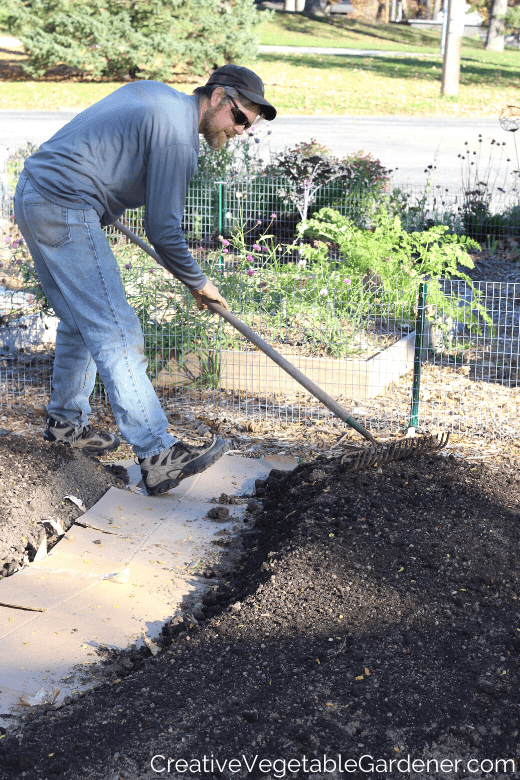
Step 1: Prep your garlic bed for planting.
You should always rotate your vegetable families each year, so ideally you’re planting your garlic in a bed that did not host any other alliums (onions, leeks, scallions) this season.
I have very clay-like soil, so I break up the soil by using my favorite garden tool, the digging fork. (I have several, including this one.) I follow that up with a garden rake to smooth out the soil surface so it’s nice and flat for planting.
In 20 years of gardening I’ve always has a no-till garden. Tilling destroys the soil structure and I hate wrestling with loud machines. Gardening should be quiet and peaceful!
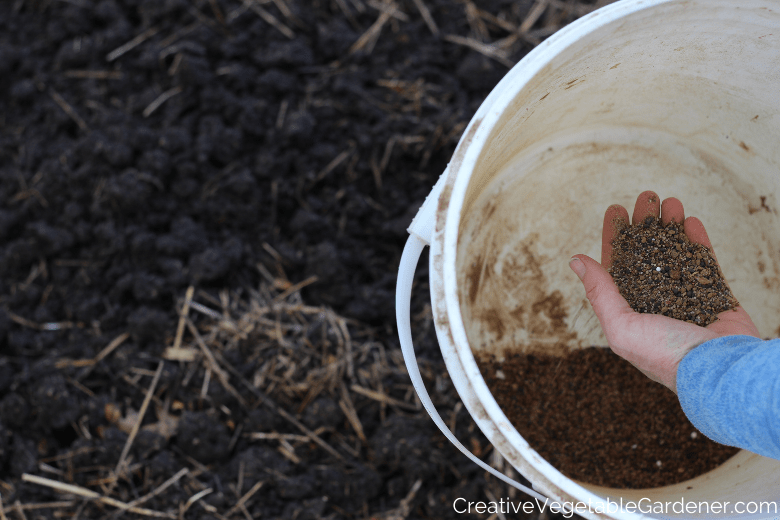
Step 2: Whether to add organic fertilizer.
Usually when I’m preparing a garden bed for planting I add a generous amount of organic fertilizer. But, the garlic won’t start growing until the following spring. Over winter it will be dormant. So, whether to add fertilizer at this point is really your choice.
If you think you’ll forget to do it in the spring, then just mix some into the garden bed now. If you’re using a granulated organic fertilizer it will be slow release, so the plants will get plenty of benefit from it in the spring.
If you don’t have any in your garden shed or you’d rather wait, just make a note to yourself that next year you should spread some around the plants after their leaves emerge in early spring.
I definitely recommend that all gardeners add an organic garden fertilizer to their gardens before each planting of seeds and plants. Read all about it, including what kinds you should buy, in this article: How to Use Organic Garden Fertilizer for Better Plants.
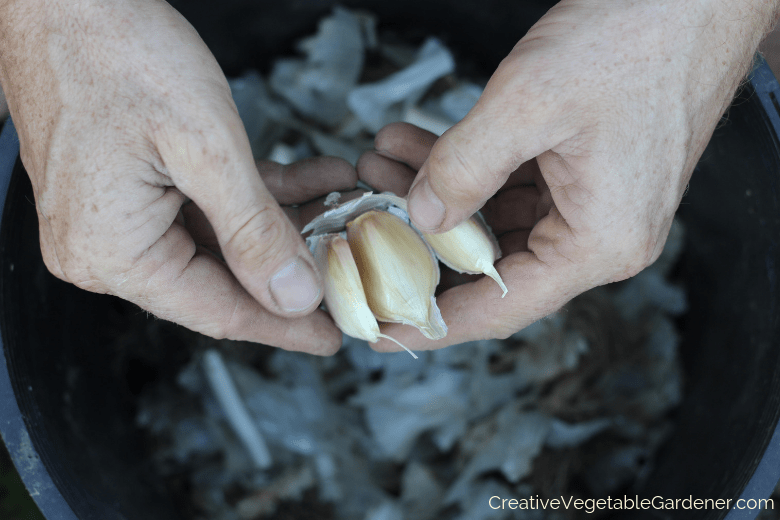
Step 3: Pop the garlic.
The cool thing about garlic is that you’re planting the individual cloves, not the entire bulb. Throughout the spring and summer next year that one clove will grow into a whole bulb by the time it’s ready to harvest.
That’s a pretty good payback, I think!
“Popping the garlic” is a fancy way of saying breaking the bulbs into the individual cloves. I usually do this over a bucket to catch the cloves and loose paper (the covering of the cloves and bulb).
Keep the paper on each clove, you don’t need to peel them. It will offer a protective layer while they’re in the ground.
If you’re planting more than one variety at a time and you want to keep track of each one, work with them separately and keep them in their own containers with a label.

Step 4: How to plant garlic in fall.
Garlic spacing is six inches between each clove on all sides. I’ve experimented with tighter spacing, 4 inches, but it resulted in smaller bulbs. Personally, bigger is better in my book!
Six inch spacing means you can fit a lot of garlic in a small space. I can usually squeeze all of my 220 cloves in two garden beds. A quick way to easily measure the distance between the cloves is to mark every six inches on your rake handle. Or you can use a measuring tape spread out over the width of the bed.
The cloves should be planted about four to six inches deep. If you can’t easily get them down into the soil that far, use a tool like a dandelion digger or trowel (link to my all-time favorite trowel!) to open up a deeper hole for the clove.
Make sure you’re planting the clove pointy side up and root side down.
When you’re finished planting use your hands to smooth out the soil and make sure each clove is well covered.
Watch the accompanying video to check out the nifty handmade tool I use for planting garlic and onions.
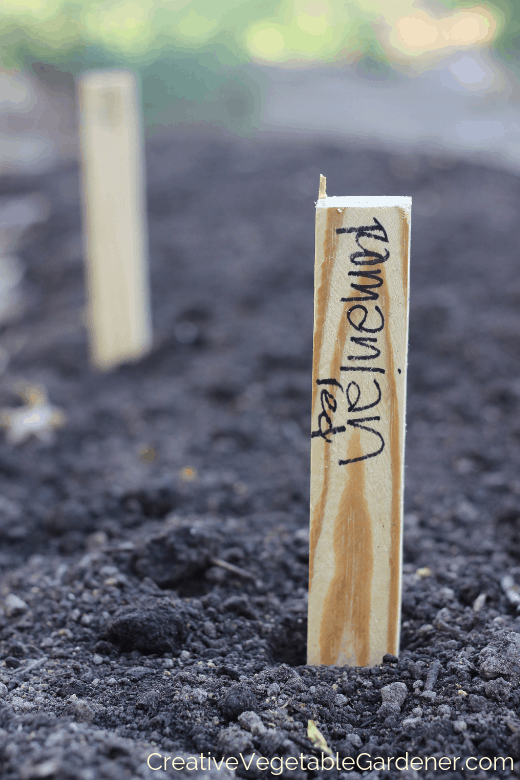
Step 5: Mark the varieties.
If you’re keeping track of your garlic varieties make sure you write them down on your garden map so you can differentiate between them next year.
I also write each variety name on a stake and pound it into the ground in front of the first row. On your map, you can also write the amount of each variety you planted so you can evaluate if it’s enough (or too much) next year.
Keeping records over time helped me figure out that 220 cloves was just about right. There’s no need for us to plant more, even when we have extra seed. It’s a waste of space and I’d rather fill that area with another favorite vegetable next spring.
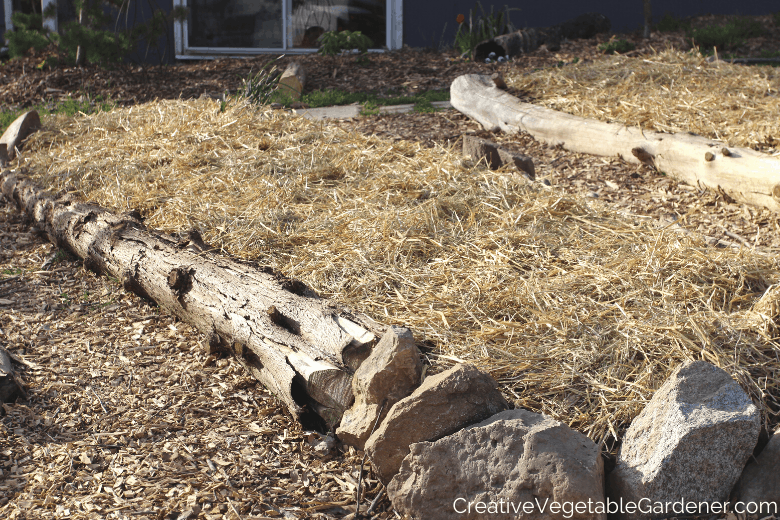
Step 6: Tuck in the garlic for winter.
After you’ve made sure the cloves are covered with soil, it’s time to mulch! Spread out a thick layer of hay, straw, leaves or grass clippings over the entire planting area.
The mulch will protect the soil from erosion from wind and rain, and drying out from the harsh winter winds. It will also keeps the weeds down in spring and early summer and regulate the soil moisture so you have to water less.
You don’t need to water the garlic after planting because it’s going to be dormant until spring.
When spring arrives, the garlic will easily come up through the mulch, there’s no need to remove it.

Step 7: Sit back and wait for spring.
There’s not much to do after planting garlic in fall and mulching the garden bed except to wait for the first sprouts when the weather warms up in the springtime. It’s so fun to see them peeking through the mulch as a signal that the new season has begun!
Garlic Care & Maintenance the Following Year
Garlic is one of the only vegetables we grow in cold climates that can survive the winter and thrive the next season.
As we talked about above, you don’t need to do anything over the winter, but come spring you should start giving your garlic plantings a bit more attention to keep them happy!
Mulch
Keep your garlic mulched throughout winter and spring. In spring you’ll notice green leaves starting to push through the mulch. They can easily get through on their own – there’s no need to remove the mulch unless you put down an extremely thick layer, then they might need some help emerging.
Keep a thick layer of vegetable garden mulch on the garden beds throughout the season until you harvest the garlic. If you can see the soil through the mulch in spring, it’s too thin. Apply more until all of the soil is covered.
Weeding
The mulch should keep down the majority of the weeds, but pull any weeds that make it through the mulch. Garlic doesn’t like to compete with weeds.

Watering
Like most vegetables, garlic needs about 1” of water per week. If it’s not raining in your garden on a regular basis you must water it. Watering deeply with a hose less frequently is better than many shallow waterings. I like using this hose and watering wand.
Deep watering will encourage the plants’ roots to go further into the soil. After early June you can ease up on the watering, they don’t mind drier conditions as they get close to maturity.
Discover for tips for watering your vegetable garden.
Fertilizing
If you didn’t add any organic garden fertilizer to your planting bed in the fall, once the leaves have sprouted in spring you can spread some around each plant.
Work it into the soil a bit with your fingers and recover any disturbed areas with the mulch. Read more about what kind of organic fertilizer to choose for your garden here.
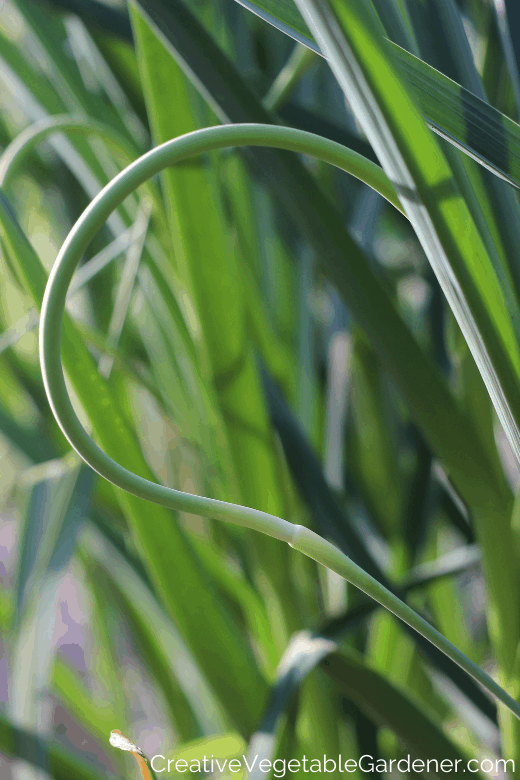
Harvest Garlic Scapes
Around early to mid-June in most areas you’ll notice the hardneck varieties start to push up their scapes. See photo above.
Cut or break off the scapes when they’re about 10” long. This will force the plant to put more energy into bulb production.
The scapes are a bonus crop! You can cook with them just as you would garlic or onions, or make them into a delicious garlic scape pesto to freeze for winter like I do.
Harvest & Cure Garlic
Around early July in colder climates, earlier in warmer ones, you’ll notice the leaves of the garlic plant start to turn brown and die. This signals that harvest time is rapidly approaching!
And if you’ve grown a lot of garlic you can cure it to store for most of the winter. In this article and video I walk you through the process of harvesting and drying your garlic.

Additional Resources for Growing Garlic
Garlic is one of the most rewarding vegetables to grow in the home garden. You can plant a large amount in a small space, it doesn’t have many pests or diseases, and it loves cold weather. It survives the harsh winters in Wisconsin where we sometimes get -40 degree F winter weather.
That’s a tough plant!
If you’ve never tried planting garlic in fall, I hope this post showed you how easy and quick it can be.
Don’t forget to check out the video below where I walk you through the process in more detail as I plant garlic in my own garden, including a few extra tips!
I have a whole handful of helpful posts about growing, harvesting and using garlic.
- Planting Garlic in Spring: It’s Not Too Late!
- Why You Should Plant Garlic This Fall
- What Kind of Garlic Should You Plant?
- The Best Recipe For Using Your Garlic Scapes
- Eat Your Own Garlic All Year Round: How to Harvest & Cure It



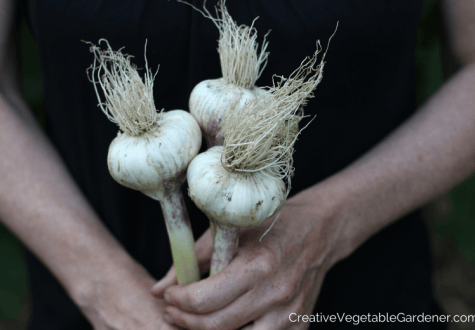




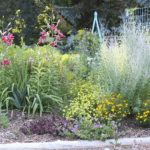
Comments
Good for you Megan! I often struggle to figure out how to balance my gardening jobs, blog and art. Congrats on your new adventures!
This is cool. I can’t wait to plant garlic and harvest fresh ones for my cooking.
Hi Megan. I stumbled upon your blog today and have already read through several posts. It is my fav blog now because you have more substance in each post. Sadly not all blogs do that. Anyhow, I have a question about planting garlic. Last year I tried planting 5 garlic cloves and got 5 bulbs (clusters) in summer. I want to plant it again this fall. Do I add compost to soil before planting garlic? Or just plant it? No one ever seems to clarify this. Also does garlic need a lot of sun in Spring to make larger bulbs? My 5 cloves were in fairly shaded areas and made small clusters than the parent cluster from which I took the cloves. Thank you for hearing me out.
Great tips, looking forward to testing this out. Love garlic and fresh would be even better, thank you!
Love it
Hello from the southern end of the state! I’m patiently waiting for the scapes then full garlic plants to ready themselves for harvest, our first planting on the new farmstead. We’ll prep and plant a new bed in autumn for the next crop, and I wonder what is your favorite plant to follow in the garlic bed once its out? Thanks so much for the great post!
Cheers,
Heather
How exciting! I replace a lot of my garlic with my last plantings of carrots and beets. The rest of the space gets saved for fall planting in mid to late August.
That’s perfect. Thank you!
I’ll be winterizing my garden on 10/17, pulling all the spent plants and adding a layer of mulch (pine needles and shredded leaves from the yard). I like to plant my garlic the first week of November when I pull most of my carrots for storage (I like to leave some that I’ll harvest at the end of November). Do you grow spinach throughout the winter? I double up on the row cover which allows the spinach to stay alive and grow VERY slowly so that I’ll have a nice early harvest in March. Happy planting!
Hi Greg! Thanks for your comment. I do plant fall spinach and overwinter it. I cover some of it with a low tunnel and some I just leave out if I’m being lazy. I find that the covered spinach bounces back more quickly in the spring. Happy Fall!